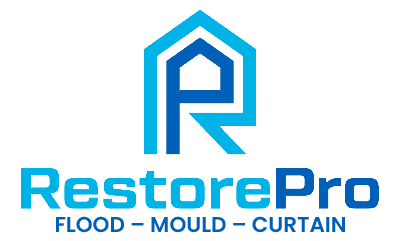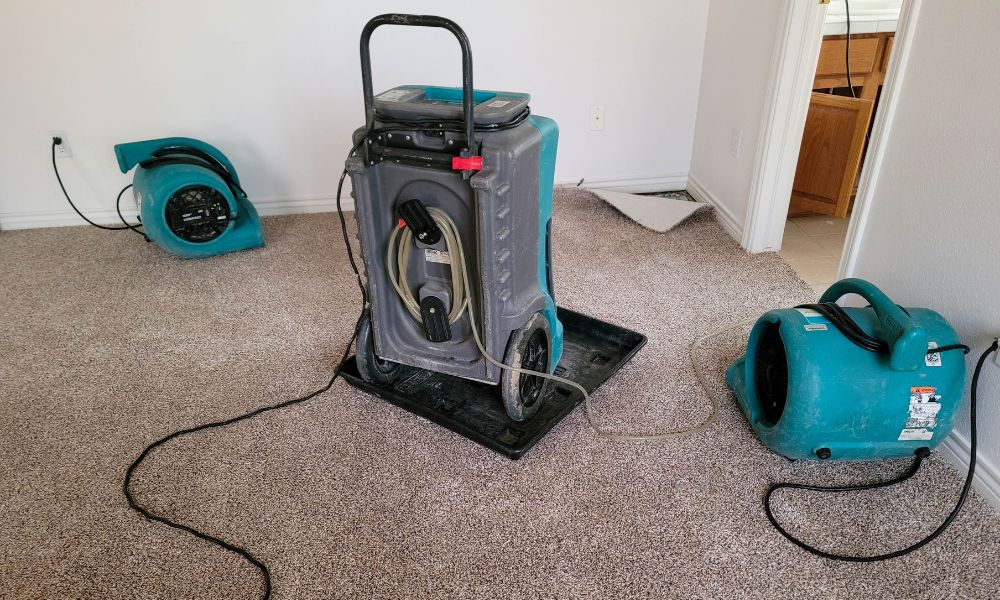Drying carpets after a flood can take anywhere from 12 hours to several days, depending on carpet material, water absorption, and room conditions. Synthetic carpets dry faster than natural fibres. Using fans, dehumidifiers, and ensuring good air flow can speed up the process.
High humidity and poor air circulation can extend drying times. Immediate action is crucial to prevent mould growth, which can start within 24 to 48 hours and pose health risks. Additionally, prolonged dampness can damage the subfloor, causing wooden floorboards to swell, warp, or rot, compromising the safety and stability of your home.
Quick and effective drying helps repair flood damage on your carpet, maintain structural integrity, and protect your home environment. Understanding these factors and using the right tools can significantly impact drying time and home safety.
What Factors Affect the Drying Time of Flooded Carpet?
Several factors influence how long it takes for a carpet to dry after being flooded. The type of carpet material plays a key role in the speed of moisture evaporation. Environmental conditions such as humidity levels and airflow are also crucial in determining the drying time. Moreover, the amount of water the carpet has absorbed, which depends on the severity of the flood, significantly affects the drying period.
To dry a flooded carpet effectively, consider these points:
- Carpet Material: Different materials dry at different rates. For instance, synthetic fibres typically dry faster than natural fibres.
- Environmental Conditions: High humidity and poor ventilation can slow down the drying process. Opening windows and using fans can help speed up drying.
- Amount of Water: The more water your carpet has absorbed, the longer it will take to dry. Extracting water with a professional-grade vacuum can reduce drying time.
- Temperature: Warmer temperatures help evaporate moisture faster. However, it’s important to balance this with good ventilation to prevent mould growth.
Influence of Carpet Material on Drying Time
When your home is affected by a flood, the drying time of your carpet can vary greatly depending on the material it’s made from. Different types of fibers such as wool, nylon, and polyester each respond differently to water, affecting how quickly your carpet can dry and be restored to its original condition.
- Wool Carpets: Made from natural, dense fibres, wool absorbs a significant amount of moisture, leading to longer drying times. Wool carpets require more time and careful attention to avoid mould and mildew, which thrive in damp conditions.
- Synthetic Fibres: Carpets made from nylon and polyester are less absorbent, allowing them to dry much faster than wool. This quicker drying time helps reduce the risk of mould and mildew formation.
The way a carpet is woven and its structure also impact how it absorbs and releases water. Thicker and denser pads, typically found under wool carpets, can absorb more water and take longer to dry. Knowing this can help you choose the right drying techniques and equipment, speeding up the recovery process.
Understanding these differences in carpet materials can help you prepare better for flood situations and make informed choices about carpet installation and flood damage strategies. Being aware of how each material behaves in wet conditions ensures you can handle the situation more effectively, reducing stress and potentially saving money on repairs.
Impact of Humidity Levels and Ventilation
In high humidity settings, the drying time for carpets can increase significantly. This is because moist air slows down the evaporation process, which is essential for drying. If the surrounding humidity isn’t managed, the moisture in the carpet fibres will persist, leading to potential damage and the risk of mould growth.
To speed up the drying process, implementing effective ventilation strategies should also be considered. Using fans and dehumidifiers can make a significant difference. Fans enhance air circulation over the carpet’s surface, boosting evaporation, while dehumidifiers remove moisture from the air, effectively lowering the room’s overall humidity level. This approach not only hastens drying but also reduces the likelihood of mould and mildew, which thrive in moist conditions.
Additionally, the amount of airflow in the room is crucial. Maintaining consistent and strong airflow helps distribute heat and lower moisture levels evenly throughout the affected area. It’s advisable to regularly check and adjust the room’s humidity levels to ensure the fastest drying time possible, thus preserving the carpet’s integrity and longevity.
Effect of the Extent of Flooding on Drying Time
When assessing how long it takes for a flooded carpet to dry, the amount of water and how soaked the carpet is are key factors. If a carpet has soaked up a lot of water, it will take longer to dry. This happens because there’s more moisture in the carpet fibres and the padding underneath, which slows down the drying process.
The depth of water penetration into the carpet and its base materials can also lead to increased drying times.
The type of material and thickness of your carpet also impact how long it will take to dry. Carpets made from synthetic fibres usually dry faster than those made from natural fibres because they absorb less water. The material underneath the carpet, known as underlay, is also crucial; heavier underlay materials hold on to moisture for longer, further delaying drying.
Using efficient water removal techniques is vital for reducing carpet drying times. Methods such as powerful water extractors and dehumidifiers can quickly remove a large amount of moisture. Good airflow is just as important; it helps move air around and lowers the moisture levels in the room, which helps the carpet dry faster.
How Can You Speed Up the Carpet Drying Process?
When you need to dry carpets quickly after a flood, it’s essential to use the right tools and methods. High-powered fans and dehumidifiers are key to increasing airflow and removing moisture. This helps speed up the drying process considerably. Additionally, using wet vacuums to suck up excess water and keeping an eye on moisture levels can make drying more efficient.
Choosing the Right Tools for Fast Carpet Drying
Selecting the proper tools, such as powerful dehumidifiers, air movers, and wet vacuums, is crucial for quickly drying carpets after flooding. These devices are designed to efficiently remove excess water and enhance evaporation, speeding up the drying process.
Dehumidifiers are especially effective as they extract large amounts of moisture from the air, helping to prevent further water damage like mould growth. When selecting a dehumidifier, it’s important to pick a model with a high moisture removal capacity appropriate for the size of the flooded area. Look for features like built-in hygrometers, which help monitor and adjust room humidity levels to optimise drying conditions.
Air movers play a vital role in the drying process as well. They generate strong airflows that push air over wet surfaces, moving moisture into the air for dehumidifiers to capture. Choosing the right number and capacity of air movers based on the room’s size and layout ensures effective drying coverage.
Together, these tools are essential for quickly drying carpets and returning conditions to normal.
Techniques to Enhance Drying Efficiency
If you’re looking to dry your carpet quickly, there are several effective techniques you can use to boost the drying efficiency. These methods will help restore your carpet to its pre-flood condition faster.
Increase Airflow
One of the best ways to speed up carpet drying is by enhancing airflow in the area. Simply open your windows and position fans strategically around the damp carpet. This will improve air circulation and significantly reduce drying time. For even faster results, consider using high-powered air movers. These are designed specifically to expedite drying by generating a more powerful airflow.
Use Dehumidifiers
Adding a dehumidifier to the room is another effective strategy. Dehumidifiers work by lowering the moisture levels in the environment, making it less conducive for moisture to persist. This not only speeds up the drying process but also helps prevent the growth of mould and mildew.
Lift the Carpet
For carpets that are extremely wet, it might be helpful to lift them slightly. This allows air to flow underneath, drying the lower surfaces more effectively. It’s a simple step that can make a big difference in overall drying time.
Monitor the Drying Process
It’s crucial to keep an eye on the drying progress. Regular monitoring allows you to check if the current methods are working or if adjustments are needed. This ensures that your carpet dries as efficiently as possible.
Can You Dry Carpet Yourself or Should You Call Professionals?
Deciding whether to dry your carpet yourself or hire professionals depends heavily on the severity of the situation. For small-scale water incidents, you might manage with DIY methods like deploying fans and dehumidifiers, which can cost around $50 to $200 depending on the equipment you use.
However, for extensive water damage or mould concerns, professional carpet drying services are recommended. Professionals have the tools and expertise to effectively manage significant water damage, ensuring your carpet is dry and free from health hazards like mould and mildew. The cost for these services typically starts at about $500 and can increase depending on the size of the area affected and the severity of the damage.
Pros and Cons of DIY Carpet Drying
Deciding whether to dry your carpet yourself or hire professionals involves considering the benefits of saving money and convenience versus the risks of ineffective results and potential mould growth. If your carpet is flooded, you might think about drying it yourself to save costs immediately. Doing it yourself also lets you manage when and how you do it, which is handy if your schedule is tight.
However, the downsides of drying your carpet yourself are substantial. Usually, the equipment you have at home isn’t as powerful as what the professionals use, which means it might take longer to dry your carpet. This delay could increase the chances of mould and mildew growing under the carpet.
Additionally, if you don’t dry your carpet correctly, it may never feel the same or last as long as it should. Although it might seem cheaper and simpler to do it yourself, this approach comes with significant risks that could end up costing you more money in the long run because of potential damage and health issues.
Situations Requiring Professional Services
When dealing with wet carpets, DIY methods might suffice for slight dampness. However, in cases of heavy saturation, especially after extensive flooding, professional flood damage restoration services are crucial. Home attempts often fail to completely dry the carpets, leading to structural harm and the spread of mould.
- Advanced Equipment:
- Professional restoration teams use high-tech equipment designed for efficient water removal and quick drying. This specialised gear far surpasses anything available to general consumers, effectively handling major water damage.
- Thorough Water Detection:
- Experts are trained to identify all areas affected by water, including hidden spots that could cause mould growth and floor damage later on. This ensures comprehensive treatment and prevents future issues.
- Complete Restoration Solutions:
- Professional services include not only drying but also cleaning and sanitising the area. They check for any damage that might affect your home’s structural safety, providing a thorough solution.
Engaging professional flood damage restoration services ensures that your carpet receives the appropriate treatment to avoid future problems. Quick and skilled intervention not only preserves your carpet but also protects your living space, saving you time and money on potential repairs.

